Gerrie Ferris Finger's Blog, page 5
April 29, 2015
On Harper Lee's Mockingbird
I was not a big fan of Harper Lee's To Kill a Mockingbird. I never got the title. I grew up in the country and the darn birds were a loud nuisance.
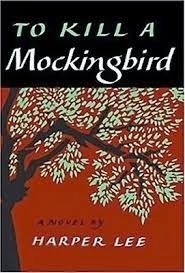
I live in the city now, and they're still a loud nuisance that steals the voices of insects, animals and other birds. At night, my word, they'll keep you awake mimicking crickets or bob whites (quail). Baaaa -- (upnote) -- White! Said over and over, it gets on one's last nerve, as we say in the South.
About the title, Sparknotes writes:
"Thus, to kill a mockingbird is to destroy innocence. Throughout the book, a number of characters (Jem, Tom Robinson, Dill, Boo Radley, Mr. Raymond) can be identified as mockingbirds—innocents who have been injured or destroyed through contact
with evil."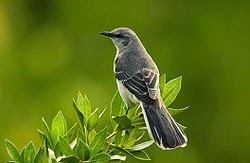 US Fish and Wildlife Photo
US Fish and Wildlife Photo
Okay. I never thought of mockingbirds as innocents, in fact they are rather crafty. Why not To Kill a Bluebird? Now that songbird, with its distinctive beloved voice, is welcome in every garden as a voracious feeder of pesky insects and are a joy to see and listen to on a lovely summer morning.
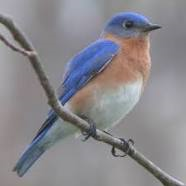 US Fish and Wildlife Photo
US Fish and Wildlife Photo
I realize I'm picking on an icon, a Pulitzer Prize winner and a sensitive author. I read the book when I was a teenager -- in school, of course -- and again about ten years ago to see if my first twinges of boredom reoccurred. It's still slow-moving like the South of the period in which it was set. (Though, by today's literary fiction standards, and length, it moves along.) And, having experienced the attitudes in the book, I appreciate the value of it in today's society. For me, the shrill of the mockingbird's voices resonates with that which is stolen rather than that which is innocent.
Told from a child's point of view, we meet the Finches (bird irony here?) one summer. Scout, her brother, Jem, and their friend, Dill, plot a way to aggravate the town weirdo, Boo Radley. Into this "innocence" the alledged rape of Mayella Ewell, the white daughter of the town drunk, occurs. That crime hardly phases the kids. But then Scout's father, Atticus Finch, is hired to defend the alleged rapist, Tom Robinson, a black man; and soon the children are witness to the town's deplorable attitudes -- racism, classism and the valiant struggle for justice against ignorance.
Harper Lee was born Nelle Harper Lee in Monroeville, Alabama on April 28, 1926, Lee wrote one novel and vowed to never write another. She helped research a book by her life-long friend, Truman Capote: In Cold Blood. However, she will publish a book that she wrote before her famous Mockingbird, titled, Go Set a Watchman, to be released in July, 2015.
As quoted in To Kill a Mockingbird, "People generally see what they look for, and hear what they listen for."
So true.
Happy Reading (whatever your preferences)
Gerrie Ferris Finger
Running with Wild Blood - 2015
http://amzn.to/1HZxd1A

I live in the city now, and they're still a loud nuisance that steals the voices of insects, animals and other birds. At night, my word, they'll keep you awake mimicking crickets or bob whites (quail). Baaaa -- (upnote) -- White! Said over and over, it gets on one's last nerve, as we say in the South.
About the title, Sparknotes writes:
"Thus, to kill a mockingbird is to destroy innocence. Throughout the book, a number of characters (Jem, Tom Robinson, Dill, Boo Radley, Mr. Raymond) can be identified as mockingbirds—innocents who have been injured or destroyed through contact
with evil."
 US Fish and Wildlife Photo
US Fish and Wildlife PhotoOkay. I never thought of mockingbirds as innocents, in fact they are rather crafty. Why not To Kill a Bluebird? Now that songbird, with its distinctive beloved voice, is welcome in every garden as a voracious feeder of pesky insects and are a joy to see and listen to on a lovely summer morning.
 US Fish and Wildlife Photo
US Fish and Wildlife PhotoI realize I'm picking on an icon, a Pulitzer Prize winner and a sensitive author. I read the book when I was a teenager -- in school, of course -- and again about ten years ago to see if my first twinges of boredom reoccurred. It's still slow-moving like the South of the period in which it was set. (Though, by today's literary fiction standards, and length, it moves along.) And, having experienced the attitudes in the book, I appreciate the value of it in today's society. For me, the shrill of the mockingbird's voices resonates with that which is stolen rather than that which is innocent.
Told from a child's point of view, we meet the Finches (bird irony here?) one summer. Scout, her brother, Jem, and their friend, Dill, plot a way to aggravate the town weirdo, Boo Radley. Into this "innocence" the alledged rape of Mayella Ewell, the white daughter of the town drunk, occurs. That crime hardly phases the kids. But then Scout's father, Atticus Finch, is hired to defend the alleged rapist, Tom Robinson, a black man; and soon the children are witness to the town's deplorable attitudes -- racism, classism and the valiant struggle for justice against ignorance.
Harper Lee was born Nelle Harper Lee in Monroeville, Alabama on April 28, 1926, Lee wrote one novel and vowed to never write another. She helped research a book by her life-long friend, Truman Capote: In Cold Blood. However, she will publish a book that she wrote before her famous Mockingbird, titled, Go Set a Watchman, to be released in July, 2015.
As quoted in To Kill a Mockingbird, "People generally see what they look for, and hear what they listen for."
So true.
Happy Reading (whatever your preferences)
Gerrie Ferris Finger
Running with Wild Blood - 2015
http://amzn.to/1HZxd1A
Published on April 29, 2015 10:16
April 21, 2015
Inspiration on the Highway from Hell
A motorcycle mama I am not. My son will attest to that -- and my grumbling fear every time he fired up his bike. He's had a fixation with motorcycles since my father bought his only grandson a motor scooter. My generous father also bought him a pony but that's for another post.
My son's last bike was a huge Harley Davidson. While I am not a rider, I, too, have been fascinated with motorcycles and the culture created by generations of hard core bikers -- and not all clubs (never gangs) are of the outlaw bent, also called 1%er's.
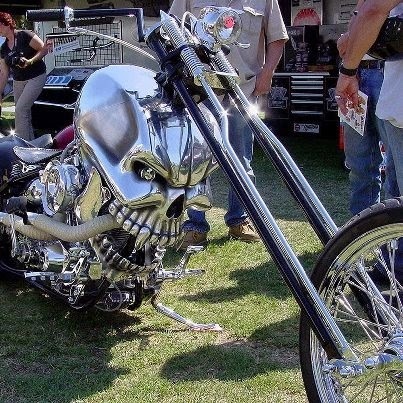 From Pinterest
From Pinterest
A couple of years ago, we were on the highway from hell -- I-95 from Georgia to Florida -- and a string of bikes flew past us. (My husband is no slouch when it comes to speed.) That's when the idea of writing a Moriah Dru/Richard Lake thriller/mystery that would feature a biker club came to me.
I know, it's so easy to connect murder with an outlaw club, which is what I made Wild Blood. But, more than that, in Running With Wild Blood I was able to explore the mystique and romance of the culture itself. I learned many arcane things from my sources, which were given to me by those who know all kinds of bikers, including outlaws.
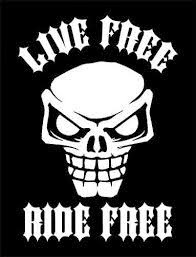
In my reporter days I met several scruffy-looking bikers at Bike Week in Myrtle Beach, S. C. They were the spokesmen (no women) -- the front men or hail-fellows of the clubs. In the last few decades, the big national clubs have campaigned to clean up their image by holding charitable bike events in places where they are welcome. In winter, Florida seems to be a magnet for Bike Weeks. Who doesn't want to get the cold north wind out of their faces?
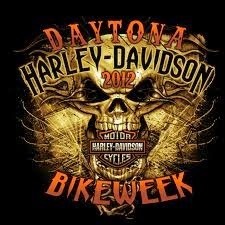
While Running with Wild Blood reflects biker practices and traditions, and bikers with hearts-of-gold, it's really about heinous murder, misunderstood people, judgmental society and those in august positions misbehaving. Center stage are Dru and Lake riding with the club to solve the mystery of it all.
Sons of Anarchy it is not.
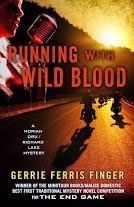
My best to readers and riders alike!
Gerrie Ferris Finger
http://amzn.to/1HZxd1A
My son's last bike was a huge Harley Davidson. While I am not a rider, I, too, have been fascinated with motorcycles and the culture created by generations of hard core bikers -- and not all clubs (never gangs) are of the outlaw bent, also called 1%er's.
 From Pinterest
From PinterestA couple of years ago, we were on the highway from hell -- I-95 from Georgia to Florida -- and a string of bikes flew past us. (My husband is no slouch when it comes to speed.) That's when the idea of writing a Moriah Dru/Richard Lake thriller/mystery that would feature a biker club came to me.
I know, it's so easy to connect murder with an outlaw club, which is what I made Wild Blood. But, more than that, in Running With Wild Blood I was able to explore the mystique and romance of the culture itself. I learned many arcane things from my sources, which were given to me by those who know all kinds of bikers, including outlaws.

In my reporter days I met several scruffy-looking bikers at Bike Week in Myrtle Beach, S. C. They were the spokesmen (no women) -- the front men or hail-fellows of the clubs. In the last few decades, the big national clubs have campaigned to clean up their image by holding charitable bike events in places where they are welcome. In winter, Florida seems to be a magnet for Bike Weeks. Who doesn't want to get the cold north wind out of their faces?

While Running with Wild Blood reflects biker practices and traditions, and bikers with hearts-of-gold, it's really about heinous murder, misunderstood people, judgmental society and those in august positions misbehaving. Center stage are Dru and Lake riding with the club to solve the mystery of it all.
Sons of Anarchy it is not.

My best to readers and riders alike!
Gerrie Ferris Finger
http://amzn.to/1HZxd1A
Published on April 21, 2015 08:28
April 15, 2015
On Being a Bookseller
I know some wonderful booksellers. Maggie Carter-de Vries at Books Plus in Fernandina Beach, Fl. is one. So is Louise at Once Upon a Bookseller in St. Marys, Ga. Their patrons are lucky for the attention they get. If you want to just browse, say so and go on and browse. If you want a suggestion, they're happy to guide you to whatever your reading pleasure happens to be.
Too many people walk into a book store, stare at the lines of shelves and piles of sale books and leave. Especially men who seem to feel like they're in a china shop.

During a recent visit to a large corporate book store, I waited to ask a store employee a question and so watched as potential book buyers entered. Although I'm an author, I was not there to sign my books.
There were several employees behind a large desk, but no one paid attention to those that entered, including me. A timid woman walked up, and I let her go ahead of me. She put her handbag on the counter, and, clutching it, waited for several minutes before someone behind the desk deigned to address her.
"You need some help?" a female clerk asked.
The woman said she was looking for a book for a co-worker's going-away present.
"What kind?"
"She likes mysteries her friend told me," the woman said.
"What kind of mysteries?" the clerk asked.
The lady shrugged. "Just mysteries, I guess. I read biographies."
"Thriller, cozy, paranormal, what?" the clerk wanted to know.
Perplexed, the woman asked, "What's cozy?"
"Unlike a thriller. More like an Agatha Christie."
"I've heard of her."
"In the back are the mystery shelves," the clerk said, and pointed the way. With that the clerk turned her back on the woman to speak to her own co-worker.
I, as an author and, therefore, a seller of my books, said, "I can help you."
Relieved, the lady smiled.
We looked through the Mystery section at cozies. "I don't think she'd like anything about animals solving murders," the lady said.
My cue. "I'm an author, and I write a cross-genre type of mystery, a mystery with thriller elements."
"That sounds about right," she said. "She likes CSI on TV."
"Probably not a cozy reader," I said. I pointed out Lee Child's Jack Reacher series and the Michael Connelly's so as not to sound too eager. After all, one sale does not a career make.
"Tell me about your books," the lady said, less timid now.
On the shelves were three of the five books in a series of mine that have been recently published.
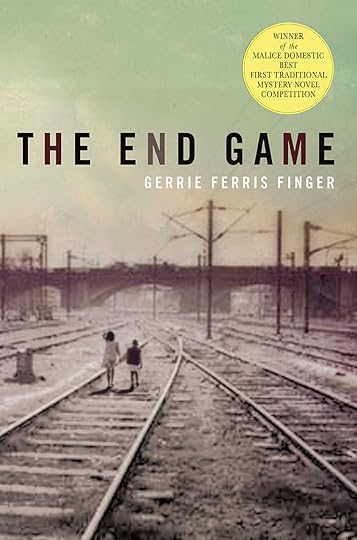 She looked at those three, picked one up, glanced at the cover, then looked at me. "I think she'd like yours. Will you autograph them?"
She looked at those three, picked one up, glanced at the cover, then looked at me. "I think she'd like yours. Will you autograph them?"
Them. Three can help a career along.
But the moral of this story is, I think that without help, the lady might have walked out and bought her friend a fancy soap in the scent boutique next door.
My best to you dear reader,
Gerrie Ferris Finger
Too many people walk into a book store, stare at the lines of shelves and piles of sale books and leave. Especially men who seem to feel like they're in a china shop.

During a recent visit to a large corporate book store, I waited to ask a store employee a question and so watched as potential book buyers entered. Although I'm an author, I was not there to sign my books.
There were several employees behind a large desk, but no one paid attention to those that entered, including me. A timid woman walked up, and I let her go ahead of me. She put her handbag on the counter, and, clutching it, waited for several minutes before someone behind the desk deigned to address her.
"You need some help?" a female clerk asked.
The woman said she was looking for a book for a co-worker's going-away present.
"What kind?"
"She likes mysteries her friend told me," the woman said.
"What kind of mysteries?" the clerk asked.
The lady shrugged. "Just mysteries, I guess. I read biographies."
"Thriller, cozy, paranormal, what?" the clerk wanted to know.
Perplexed, the woman asked, "What's cozy?"
"Unlike a thriller. More like an Agatha Christie."
"I've heard of her."
"In the back are the mystery shelves," the clerk said, and pointed the way. With that the clerk turned her back on the woman to speak to her own co-worker.
I, as an author and, therefore, a seller of my books, said, "I can help you."
Relieved, the lady smiled.
We looked through the Mystery section at cozies. "I don't think she'd like anything about animals solving murders," the lady said.
My cue. "I'm an author, and I write a cross-genre type of mystery, a mystery with thriller elements."
"That sounds about right," she said. "She likes CSI on TV."
"Probably not a cozy reader," I said. I pointed out Lee Child's Jack Reacher series and the Michael Connelly's so as not to sound too eager. After all, one sale does not a career make.
"Tell me about your books," the lady said, less timid now.
On the shelves were three of the five books in a series of mine that have been recently published.
 She looked at those three, picked one up, glanced at the cover, then looked at me. "I think she'd like yours. Will you autograph them?"
She looked at those three, picked one up, glanced at the cover, then looked at me. "I think she'd like yours. Will you autograph them?"Them. Three can help a career along.
But the moral of this story is, I think that without help, the lady might have walked out and bought her friend a fancy soap in the scent boutique next door.
My best to you dear reader,
Gerrie Ferris Finger
Published on April 15, 2015 09:02
April 9, 2015
At The Masters: Augusta National - A Gardener's Delight
The August National Golf Course was formerly a plant nursery and each hole on the course is named after the tree or shrub with which it has become associated. Several of the holes on the first nine have been renamed.
First Nine (Masters’ folks don’t like the term “front nine.”)
First Tee: Tea Olive; Second: Pink Dogwood; Third: Flowering Peach; Fourth: Flowering Crab Apple;
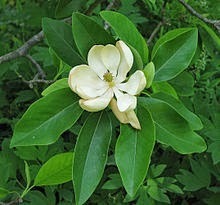 Magnolia
Magnolia
Fifth: Magnolia; Sixth: Juniper; Seventh: Pampas; Eighth: Yellow Jasmine; Ninth: Carolina Cherry.
Second Nine:
Tenth hole: Camellia; Eleventh: White Dogwood; Twelfth: Golden Bell; Thirteenth: Azalea; Fourteenth: Chinese Fir; Fifteenth: Firethorn; Sixteenth: Redbud; Seventeenth: Nandina; Eighteenth: Holly.
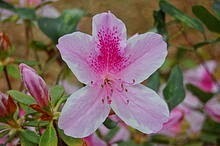 Azalea
Azalea
Unlike most other private or public golf courses in the United States, Augusta National has never been rated. During the 1990 Masters Tournament, a team of USGA raters, organized by Golf Digest, evaluated the course and gave it an unofficial rating of 76.2. It was re-evaluated in 2009 and given an unofficial rating of 78.1.
The golf course architecture website GolfClubAtlas.com has said, “Augusta National has gone through more changes since its inception than any of the world’s twenty or so greatest courses. To call it a MacKenzie course is false advertising as his features are essentially long gone and his routing is all that is left.” The architects, it is said, was strongly influenced by the Old Course at St Andrews, and intended that the ground game be central to the course.
However, almost from Augusta’s opening, Roberts sought to make changes to minimize the ground game, and effectively got free rein to do so because MacKenzie died shortly after the course’s opening and Jones went into inactivity due to World War II and then a crippling illness. The authors add, “With the ground game gone, the course was especially vulnerable to changes in technology, and this brought on a slew of changes from at least 15 different ‘architects’.
Source: Wikipedia.
Enjoy the Game!
Gerrie Ferris Finger
First Nine (Masters’ folks don’t like the term “front nine.”)
First Tee: Tea Olive; Second: Pink Dogwood; Third: Flowering Peach; Fourth: Flowering Crab Apple;
 Magnolia
MagnoliaFifth: Magnolia; Sixth: Juniper; Seventh: Pampas; Eighth: Yellow Jasmine; Ninth: Carolina Cherry.
Second Nine:
Tenth hole: Camellia; Eleventh: White Dogwood; Twelfth: Golden Bell; Thirteenth: Azalea; Fourteenth: Chinese Fir; Fifteenth: Firethorn; Sixteenth: Redbud; Seventeenth: Nandina; Eighteenth: Holly.
 Azalea
AzaleaUnlike most other private or public golf courses in the United States, Augusta National has never been rated. During the 1990 Masters Tournament, a team of USGA raters, organized by Golf Digest, evaluated the course and gave it an unofficial rating of 76.2. It was re-evaluated in 2009 and given an unofficial rating of 78.1.
The golf course architecture website GolfClubAtlas.com has said, “Augusta National has gone through more changes since its inception than any of the world’s twenty or so greatest courses. To call it a MacKenzie course is false advertising as his features are essentially long gone and his routing is all that is left.” The architects, it is said, was strongly influenced by the Old Course at St Andrews, and intended that the ground game be central to the course.
However, almost from Augusta’s opening, Roberts sought to make changes to minimize the ground game, and effectively got free rein to do so because MacKenzie died shortly after the course’s opening and Jones went into inactivity due to World War II and then a crippling illness. The authors add, “With the ground game gone, the course was especially vulnerable to changes in technology, and this brought on a slew of changes from at least 15 different ‘architects’.
Source: Wikipedia.
Enjoy the Game!
Gerrie Ferris Finger
Published on April 09, 2015 14:17
April 6, 2015
THE MASTERS -- a tournament like no other
Like most golfers, I have an profound attraction toward The Masters. Is Augusta National, the home of the April tournament, the most hallowed grounds in all of golf? Not to me. I love, love, love all golf courses. I love the game. Like all amateurs and professionals, we strive to get better. Some err on the side of too much tinkering, but not me. I have no patience for hours of practice.
Over the years as a reporter in Georgia where The Masters was born and reached hallowed status, I’ve reported on and been on the fairways of the beautiful course. I never stepped foot on a green because I’ve never played the course. It wasn’t until a few years back that a woman actually joined the previously good ol’ boys venue. (I doubt august members of the club like me calling it a venue, though.) More on words later.
The history of Augusta National is more than golf to Georgia. It was once a large orchard called Fruitland Nurseries. Owned and operated by the P.J. Berckmans, the Peach State can thank Fruitland for planting millions of peach trees in the 1800s and early 1900s.

The Masters is one of the most unusual events in sports. It’s all about (stuffy, some would say) tradition.
The Masters would never have been created if the USGA hadn’t turned down Bobby Jones’ request to host the 1934 US Open. Angry at the snub, Jones and Clifford Roberts decided to stage their own tournament. Take that, USGA.
On-air commentators are forbidden to use normal golf terms -- “championship” being the biggie. The U.S. Open, British Open, and PGA are championships. The Masters is an invitational tournament. The winner is not the champion. Some other words you won’t hear are: “fans,” “bleachers,” “sand traps. The preferred words are “patrons,” “observation stands,” “bunkers.”
Amateurs have always been invited to The Masters, but Jones himself was no amateur due to his equipment deals and monies made outside the actual game. However, in the eyes of The Masters, which he founded, he is considered an amateur.
If you’re the winner of The Masters, you get a green jacket like a beauty pageant winner during her crowning ceremony. The Jacket dates back to the forties when members started wearing a green jacket so as to be identifiable by patrons Also, when a member hosted guests in the clubhouse, the green jacket designated who got the check.
Patron respect of the hallowed course and the invitational is phenomenal. Marshals need not hold up “Quiet Please” signs because everyone respects the tournament. The people are not a crowd or even a gallery, they are patrons. They do not run from hole to hole, like in so many other “championships.” Use a term like “mob” as one commentator did and you will not be invited back next year or thereafter.
What does it cost to be an Augusta National member? Not as much I thought. Every year when I did a newspaper piece for The Masters, I’d call the membership director and ask that silly question. I was told that membership is private in all ways. They did not “out” members, even though it got around that Warren Buffett and Bill Gates had joined. Rumor has it that it costs less than a $100,000 to join which is peanuts -- without the gallery -- to the initiation fees of many prestigious golf clubs. Should you be invited as a guest by a member, the round is said to cost a niggling forty bucks.
Money is evidently not everything to Augusta National. While hot dogs are the staples of baseball, pimento cheese sandwiches are the premier nourishment at The Masters. The sandwiches sell for $1.50. But there was an uproar in 2013 over the change in the recipe. A patron said he was fine with adding female members, and even tolerant of belly putters, but changing the recipe of the pimento cheese sandwich went too damn far.
Next: The trees of Augusta National.
Respectfully submitted,
Gerrie Ferris Finger
Masters' Patron.
Over the years as a reporter in Georgia where The Masters was born and reached hallowed status, I’ve reported on and been on the fairways of the beautiful course. I never stepped foot on a green because I’ve never played the course. It wasn’t until a few years back that a woman actually joined the previously good ol’ boys venue. (I doubt august members of the club like me calling it a venue, though.) More on words later.
The history of Augusta National is more than golf to Georgia. It was once a large orchard called Fruitland Nurseries. Owned and operated by the P.J. Berckmans, the Peach State can thank Fruitland for planting millions of peach trees in the 1800s and early 1900s.

The Masters is one of the most unusual events in sports. It’s all about (stuffy, some would say) tradition.
The Masters would never have been created if the USGA hadn’t turned down Bobby Jones’ request to host the 1934 US Open. Angry at the snub, Jones and Clifford Roberts decided to stage their own tournament. Take that, USGA.
On-air commentators are forbidden to use normal golf terms -- “championship” being the biggie. The U.S. Open, British Open, and PGA are championships. The Masters is an invitational tournament. The winner is not the champion. Some other words you won’t hear are: “fans,” “bleachers,” “sand traps. The preferred words are “patrons,” “observation stands,” “bunkers.”
Amateurs have always been invited to The Masters, but Jones himself was no amateur due to his equipment deals and monies made outside the actual game. However, in the eyes of The Masters, which he founded, he is considered an amateur.
If you’re the winner of The Masters, you get a green jacket like a beauty pageant winner during her crowning ceremony. The Jacket dates back to the forties when members started wearing a green jacket so as to be identifiable by patrons Also, when a member hosted guests in the clubhouse, the green jacket designated who got the check.
Patron respect of the hallowed course and the invitational is phenomenal. Marshals need not hold up “Quiet Please” signs because everyone respects the tournament. The people are not a crowd or even a gallery, they are patrons. They do not run from hole to hole, like in so many other “championships.” Use a term like “mob” as one commentator did and you will not be invited back next year or thereafter.
What does it cost to be an Augusta National member? Not as much I thought. Every year when I did a newspaper piece for The Masters, I’d call the membership director and ask that silly question. I was told that membership is private in all ways. They did not “out” members, even though it got around that Warren Buffett and Bill Gates had joined. Rumor has it that it costs less than a $100,000 to join which is peanuts -- without the gallery -- to the initiation fees of many prestigious golf clubs. Should you be invited as a guest by a member, the round is said to cost a niggling forty bucks.
Money is evidently not everything to Augusta National. While hot dogs are the staples of baseball, pimento cheese sandwiches are the premier nourishment at The Masters. The sandwiches sell for $1.50. But there was an uproar in 2013 over the change in the recipe. A patron said he was fine with adding female members, and even tolerant of belly putters, but changing the recipe of the pimento cheese sandwich went too damn far.
Next: The trees of Augusta National.
Respectfully submitted,
Gerrie Ferris Finger
Masters' Patron.
Published on April 06, 2015 14:31
April 3, 2015
Movable Feasts
The Jewish lunar year is the basis for Jewish and Christian movable feasts, those annual holidays that do not fall on a fixed date but vary according to astronomical occurrences. Passover fell just before the Crucifixion and Resurrection of Christ, and while the two holidays come together from time to time, like this year, often they do not. For those perplexed by the seemingly random times when Passover and Easter fall on the same dates, here's wading in the weeds to you.
The Jewish calendar year begins in the Fall with the celebration of Rosh Hashana. Unlike the Christian solar year, the Jewish calendar uses twelve lunar months of alternating 29 and 30 days. The new moon marks the beginning of each month with the full moon occurring halfway through the month. The seventh month in a normal Jewish calendar year is the month of Nisan. Passover falls on the 14th day of Nisan at the time of the full moon. However, owing to the differences in the solar and lunar calendars, during a Jewish leap year an additional month of 29 days is inserted before the month of Nisan. The extra month realigns the Jewish calendar year with the seasons of the solar year. The Torah commands that Passover be celebrated in the Spring.
The early Christian church was faced with the following conflict in dates: Jesus rose on a Sunday, but Passover can fall on various days of the week. So the early church saw two options: Celebrate Easter in relation to Nisan without regard for the day of the week, or create a system whereby Easter could always be celebrated on a Sunday. That's when the difference between an ecclesiastic full moon and an astronomical full moon came into play, the former determined from ecclesiastical tables. Throw in the conflict between a fixed date for the vernal (Spring) equinox (March 21) versus the actual (meridian) date of the equinox.
The issue was hotly debated and variously practiced during the first centuries of the church. For instance, Easter was celebrated on different days in different places in the same year. The Council of Nicea in 325 A.D. eventually adopted the current system of celebrating Easter on the Sunday following the (Passover or ecclesiastical full moon) after the vernal equinox.
April 4, 2015 - April 11, 2015 :
Passover
Passover, or Pesach in Hebrew, the holiday commemorating the Hebrews' exodus from slavery in Egypt, lasts seven days in Israel and among Reform Jews, and eight days elsewhere around the world. It begins on the 14th day of Nisan and ends on the 21st of Nisan in Israel (and for Reform Jews) and on the 22nd of Nisan elsewhere.
April 5, 2015 :
Easter
(Western Churches--Catholic, Protestant)
Easter is calculated as the first Sunday after the Passover full moon that occurs on or after the vernal equinox -- a fixed date of March 21. If the ecclesiastical full moon falls on a Sunday, then Easter is the following Sunday. The holiday can occur anywhere between March 22 and April 25.
April 12, 2015
Easter
(Orthodox Church)
The Orthodox church bases the date on a slightly different calendar—the Julian calendar instead of the Gregorian. Unlike the Western Church, the Eastern Church sets the date of Easter according to the actual vernal equinox as observed along the meridian of Jerusalem, site of the Crucifixion and Resurrection.
Happy Passover and Easter
Gerrie Ferris Finger
The Jewish calendar year begins in the Fall with the celebration of Rosh Hashana. Unlike the Christian solar year, the Jewish calendar uses twelve lunar months of alternating 29 and 30 days. The new moon marks the beginning of each month with the full moon occurring halfway through the month. The seventh month in a normal Jewish calendar year is the month of Nisan. Passover falls on the 14th day of Nisan at the time of the full moon. However, owing to the differences in the solar and lunar calendars, during a Jewish leap year an additional month of 29 days is inserted before the month of Nisan. The extra month realigns the Jewish calendar year with the seasons of the solar year. The Torah commands that Passover be celebrated in the Spring.
The early Christian church was faced with the following conflict in dates: Jesus rose on a Sunday, but Passover can fall on various days of the week. So the early church saw two options: Celebrate Easter in relation to Nisan without regard for the day of the week, or create a system whereby Easter could always be celebrated on a Sunday. That's when the difference between an ecclesiastic full moon and an astronomical full moon came into play, the former determined from ecclesiastical tables. Throw in the conflict between a fixed date for the vernal (Spring) equinox (March 21) versus the actual (meridian) date of the equinox.
The issue was hotly debated and variously practiced during the first centuries of the church. For instance, Easter was celebrated on different days in different places in the same year. The Council of Nicea in 325 A.D. eventually adopted the current system of celebrating Easter on the Sunday following the (Passover or ecclesiastical full moon) after the vernal equinox.
April 4, 2015 - April 11, 2015 :
Passover
Passover, or Pesach in Hebrew, the holiday commemorating the Hebrews' exodus from slavery in Egypt, lasts seven days in Israel and among Reform Jews, and eight days elsewhere around the world. It begins on the 14th day of Nisan and ends on the 21st of Nisan in Israel (and for Reform Jews) and on the 22nd of Nisan elsewhere.
April 5, 2015 :
Easter
(Western Churches--Catholic, Protestant)
Easter is calculated as the first Sunday after the Passover full moon that occurs on or after the vernal equinox -- a fixed date of March 21. If the ecclesiastical full moon falls on a Sunday, then Easter is the following Sunday. The holiday can occur anywhere between March 22 and April 25.
April 12, 2015
Easter
(Orthodox Church)
The Orthodox church bases the date on a slightly different calendar—the Julian calendar instead of the Gregorian. Unlike the Western Church, the Eastern Church sets the date of Easter according to the actual vernal equinox as observed along the meridian of Jerusalem, site of the Crucifixion and Resurrection.
Happy Passover and Easter
Gerrie Ferris Finger
Published on April 03, 2015 07:52
March 29, 2015
What is your book about?
I do a lot of radio and radio/TV (where a static photo of me appears on the screen while I'm interviewed from my desk at home speaking into the phone while wearing pajamas). I go to fairs, festivals, signings and in all these venues I'm asked, "What is your book about?"
I try not to crack wise and say, "Oh, just about everything: life, love, hate, death, fear, triumph, tragedy -- you name it, it's in my writing." Which is true, but that's too throwaway. Better to say, "It's a murder mystery, with thriller elements like when the vengeful bad guy is revealed and gets in a gun battle with Dru and Lake, my heroine and hero." Not too illuminating, either, you say?
If I don't come up with a better answer, the questioner (host) will come up with a more pointed question. "Tell us the story, the plot."

"Ah," I say, but don't explain that the plot is a device that tells what the book is about: life, love, hate, death, fear, triumph, tragedy. It's the backbone that supports the characters motivations. So I launch into the plot of my latest, Running with Wild Blood. "It's about an outlaw biker club that is accused of murdering a young girl. The case goes cold when the cops don't solve it right away, but then a few years later a witness regains his memory of that night, and ..."
What the book is about is a young teen, Juliet Trapp, coming into the fullness of life, thinking it's a thrill-a-minute and she's immortal, juxtaposed against her friend, Bunny Raddison. who learns too soon that life is full of grief born of her own desires and fears.
We learn along the way, in this fifth book in the series, more about Moriah Dru and Richard Lake, and who the other characters are, their visions, why they've taken the path in life that they have. Even how some look death in the face and triumph.
Gerrie Ferris Finger
I try not to crack wise and say, "Oh, just about everything: life, love, hate, death, fear, triumph, tragedy -- you name it, it's in my writing." Which is true, but that's too throwaway. Better to say, "It's a murder mystery, with thriller elements like when the vengeful bad guy is revealed and gets in a gun battle with Dru and Lake, my heroine and hero." Not too illuminating, either, you say?
If I don't come up with a better answer, the questioner (host) will come up with a more pointed question. "Tell us the story, the plot."

"Ah," I say, but don't explain that the plot is a device that tells what the book is about: life, love, hate, death, fear, triumph, tragedy. It's the backbone that supports the characters motivations. So I launch into the plot of my latest, Running with Wild Blood. "It's about an outlaw biker club that is accused of murdering a young girl. The case goes cold when the cops don't solve it right away, but then a few years later a witness regains his memory of that night, and ..."
What the book is about is a young teen, Juliet Trapp, coming into the fullness of life, thinking it's a thrill-a-minute and she's immortal, juxtaposed against her friend, Bunny Raddison. who learns too soon that life is full of grief born of her own desires and fears.
We learn along the way, in this fifth book in the series, more about Moriah Dru and Richard Lake, and who the other characters are, their visions, why they've taken the path in life that they have. Even how some look death in the face and triumph.
Gerrie Ferris Finger
Published on March 29, 2015 10:49
March 22, 2015
Springtime in the Southern Garden
Yes, we delight in seeing daffodils and crocuses raising their blossomy heads in the snow or slop of early spring -- depending on where we live. I live in Georgia and this year we had snow!
 Daffodil
Daffodil
I love to see the Cosmos blooms and always recall their Greek meaning: "a balanced universe."
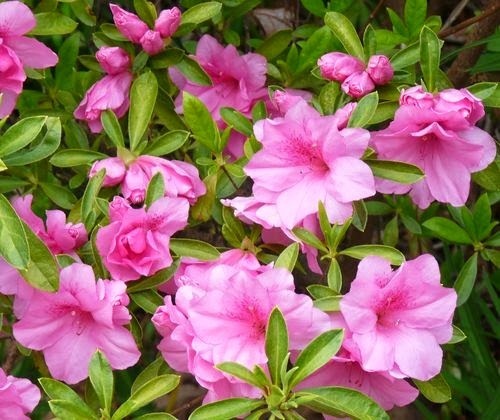 Azalea
Azalea
But what really balances our universe in the South is the Azalea. Drive down any Southern street from Georgia to Louisiana and check the yards. No matter how grand or humble it will have at least one of these hardy flowering shrubs. But just because they’re common doesn’t make them any less fascinating and beautiful. Azaleas come in riot of colors and sizes to suit any space and purpose. For the last ten years botanists have hybridized the old faithful's into varieties that bloom multiple times a year.
 Rhododendron
Rhododendron
Rhododendrons, close cousins to Azaleas, however, are not so accommodating, even though I love them and try to make them happy. They are rather finicky about their environment: the soil -- too wet, too dry -- the sun, too strong, too clouded. Did I say I love them? I delight when we drive north and see them in the wild, in the highlands of North and South Carolina. This ancient Greek rhodon or English rose can be evergreen or deciduous and comes to us from Asia.
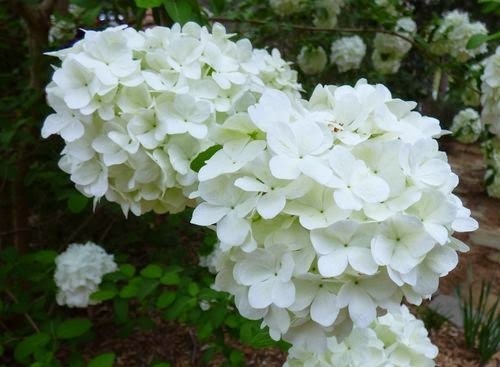 Viburnum
Viburnum
The Snowy Viburnum shrubs in my yard are budding. In a few weeks their honeysuckle smell will invade our senses. No surprise it is in the honeysuckle family, (Caprifoliaceae) This broad family raises many species and varieties of trees and shrubs.
Many viburnums put on a showy display, producing flowers in an arrangement called a corymb. Some species are edible, while others are somewhat poisonous.
 Wiegela Rosy-pink flowers add a touch of romance when displayed against the dark glossy foliage. The foliage is much darker than that of older varieties like 'Java Red'. It contrasts beautifully with the rosy-pink flowers, making for a high impact display in the garden. This variety produces copious amounts of flowers in spring, and will bloom throughout the summer. The trumpet-like flowers are adored by hummingbirds! It is fast growing and trouble free, making it an easy way to add season long color to the garden.
Wiegela Rosy-pink flowers add a touch of romance when displayed against the dark glossy foliage. The foliage is much darker than that of older varieties like 'Java Red'. It contrasts beautifully with the rosy-pink flowers, making for a high impact display in the garden. This variety produces copious amounts of flowers in spring, and will bloom throughout the summer. The trumpet-like flowers are adored by hummingbirds! It is fast growing and trouble free, making it an easy way to add season long color to the garden.
Happy Spring
Happy Gardening Gerrie Ferris FingerRunning with Wild Bloodat stores, online, libraries
 Daffodil
Daffodil I love to see the Cosmos blooms and always recall their Greek meaning: "a balanced universe."
 Azalea
AzaleaBut what really balances our universe in the South is the Azalea. Drive down any Southern street from Georgia to Louisiana and check the yards. No matter how grand or humble it will have at least one of these hardy flowering shrubs. But just because they’re common doesn’t make them any less fascinating and beautiful. Azaleas come in riot of colors and sizes to suit any space and purpose. For the last ten years botanists have hybridized the old faithful's into varieties that bloom multiple times a year.
 Rhododendron
RhododendronRhododendrons, close cousins to Azaleas, however, are not so accommodating, even though I love them and try to make them happy. They are rather finicky about their environment: the soil -- too wet, too dry -- the sun, too strong, too clouded. Did I say I love them? I delight when we drive north and see them in the wild, in the highlands of North and South Carolina. This ancient Greek rhodon or English rose can be evergreen or deciduous and comes to us from Asia.
 Viburnum
ViburnumThe Snowy Viburnum shrubs in my yard are budding. In a few weeks their honeysuckle smell will invade our senses. No surprise it is in the honeysuckle family, (Caprifoliaceae) This broad family raises many species and varieties of trees and shrubs.
Many viburnums put on a showy display, producing flowers in an arrangement called a corymb. Some species are edible, while others are somewhat poisonous.
 Wiegela Rosy-pink flowers add a touch of romance when displayed against the dark glossy foliage. The foliage is much darker than that of older varieties like 'Java Red'. It contrasts beautifully with the rosy-pink flowers, making for a high impact display in the garden. This variety produces copious amounts of flowers in spring, and will bloom throughout the summer. The trumpet-like flowers are adored by hummingbirds! It is fast growing and trouble free, making it an easy way to add season long color to the garden.
Wiegela Rosy-pink flowers add a touch of romance when displayed against the dark glossy foliage. The foliage is much darker than that of older varieties like 'Java Red'. It contrasts beautifully with the rosy-pink flowers, making for a high impact display in the garden. This variety produces copious amounts of flowers in spring, and will bloom throughout the summer. The trumpet-like flowers are adored by hummingbirds! It is fast growing and trouble free, making it an easy way to add season long color to the garden.Happy Spring
Happy Gardening Gerrie Ferris FingerRunning with Wild Bloodat stores, online, libraries
Published on March 22, 2015 08:29
March 18, 2015
Being Out There
Online promotion is a tool in the writer's marketing kit. When you're new at publishing, it helps to get your name out there; when you're an old hand, it helps to remind people that you're still out there.

Web promo doesn't feel like promo to me. I sit at my desk and still enjoy the company of friends on Google+, DorothyL, Crimescene Writers, Sisters in Crime, Facebook, Twitter, GoodReads, Library Thing, Tumblr, Pinterest. I enjoy blogging and reading others' blogs.
One cannot live by writing alone, or I can't. But I have to limit myself to two hours online per day, or less, before getting to the business of editing and writing. That includes writing blogs like this one. Sometimes in the evening, I'll get on Facebook where a different group of friends have gathered.
It's promotion, but it isn't. It's like talking to a friend on the telephone about your day, the weather, the books and films you like, and, oh by the way, your own books. It's not at all like meeting people at public at events where you talk solely about your books (and the creation thereof) or sign them for those who buy. I can't put a two-hour max on these appearances, all of which take me out of writing and editing
Thanks for reading and I'd like your comments.
Gerrie Ferris Finger
Running with Wild Blood - Jan. 2015.

Web promo doesn't feel like promo to me. I sit at my desk and still enjoy the company of friends on Google+, DorothyL, Crimescene Writers, Sisters in Crime, Facebook, Twitter, GoodReads, Library Thing, Tumblr, Pinterest. I enjoy blogging and reading others' blogs.
One cannot live by writing alone, or I can't. But I have to limit myself to two hours online per day, or less, before getting to the business of editing and writing. That includes writing blogs like this one. Sometimes in the evening, I'll get on Facebook where a different group of friends have gathered.
It's promotion, but it isn't. It's like talking to a friend on the telephone about your day, the weather, the books and films you like, and, oh by the way, your own books. It's not at all like meeting people at public at events where you talk solely about your books (and the creation thereof) or sign them for those who buy. I can't put a two-hour max on these appearances, all of which take me out of writing and editing
Thanks for reading and I'd like your comments.
Gerrie Ferris Finger
Running with Wild Blood - Jan. 2015.
Published on March 18, 2015 08:09
March 14, 2015
March 14--Pi Day and Bogey's Birthday

Pi Day is the annual commemoration of a mathematical brain twister. Celebrated today, March 14th (3/14) around the world, Pi (Greek letter “π”) is the symbol used in mathematics to represent a constant — the ratio of the circumference of a circle to its diameter — which is approximately 3.14159.
Pi has been calculated to over one trillion digits beyond its decimal point. As an irrational and transcendental number, it will continue infinitely without repetition or pattern. While only a handful of digits are needed for typical calculations, Pi’s infinite nature makes it a fun challenge to memorize, and to computationally calculate more and more digits.
Since 3, 1, and 4 are the first three digits of π in decimal form. The digits appear in this order in the ISO international standard for representing dates (YYYY-MM-DD): 2015-03-14.
Pi Approximation Day is observed on July 22 (or 22/7 in the day/month date format), since the fraction 22⁄7 is a common approximation of Pi, which is accurate to two decimal places and dates from Archimedes.
A sequential time occurs on 3/14/15 at 9:26:53.58979... following the sequence of Pi to all digits, using the America-based system of dating. If the particular date existed, the holiday would be celebrated elsewhere on April 31, as America is the only country that uses the month-first date system.
Bogey, our black Standard Poodle was born on Pi Day. No wonder he's so smart. Happy 13th, Bogey-Boy.

Published on March 14, 2015 07:15



